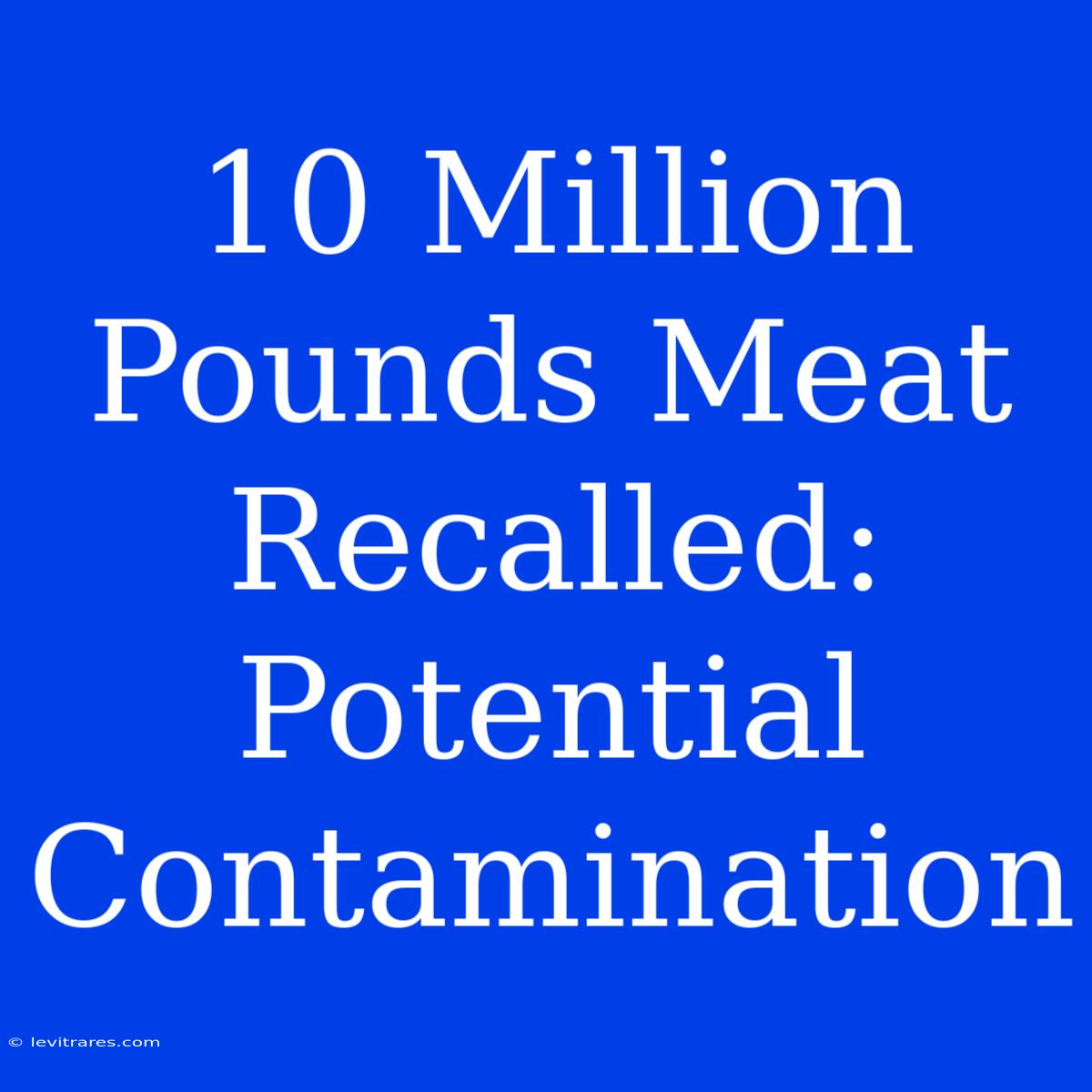10 Million Pounds of Meat Recalled: Potential Contamination Raises Concerns
Is the safety of your food at risk? A staggering 10 million pounds of meat recall due to potential contamination is sending shockwaves through the industry and raising questions about food safety practices.
Editor Note: This meat recall, potentially impacting millions, highlights the critical importance of understanding food safety procedures and staying informed about potential risks.
This significant recall underscores the need for meticulous attention to food safety protocols at every stage, from production to distribution. The potential presence of contaminants can have serious health consequences, emphasizing the importance of understanding the factors contributing to foodborne illnesses and taking necessary precautions.
Our Analysis: We delved into the details of this meat recall, investigating the source of contamination, the types of products affected, and the potential health risks involved. We analyzed data from public health agencies, industry reports, and scientific studies to create this comprehensive guide, empowering you to make informed decisions about your food choices.
Key Takeaways of This Meat Recall:
| Aspect | Details |
|---|---|
| Products Affected | Variety of meat products, including ground beef, sausages, and other processed meat items. |
| Source of Contamination | Potential contamination identified during routine inspections and investigations. |
| Health Risks | Possible foodborne illness, including Salmonella, E. coli, and other harmful bacteria. |
| Recall Procedure | Consumers advised to check product labels and dispose of affected items immediately. |
| Government Response | Public health agencies actively monitoring the situation and providing updates to the public. |
| Industry Impact | Significant financial losses for meat producers and distributors. |
| Consumer Confidence | Potential erosion of consumer trust in the food industry. |
Meat Recall
This meat recall underscores the multifaceted aspects of food safety. Understanding these aspects is crucial for consumers and industry professionals alike.
Key Aspects:
- Contamination Sources: This includes biological (bacteria, viruses), chemical (pesticides, cleaning agents), and physical (foreign objects) contamination.
- Food Handling Practices: Proper hygiene, temperature control, and cross-contamination prevention are essential.
- Inspection and Regulation: Strict regulations and regular inspections are vital for maintaining food safety standards.
- Consumer Awareness: Educating consumers about safe food handling practices and potential risks is crucial.
- Recall Procedures: Efficient and effective recall procedures are critical for mitigating the impact of contamination.
Contamination Sources
- Biological Contaminants: The most common source of contamination is bacteria, which can multiply rapidly in food.
- Chemical Contaminants: These can include pesticides, cleaning agents, and heavy metals, often entering the food chain through agricultural practices or processing.
- Physical Contaminants: This includes foreign objects like glass, metal, or plastic that can accidentally find their way into food.
Food Handling Practices
- Maintaining Cleanliness: Wash hands, surfaces, and utensils thoroughly before and after handling food.
- Temperature Control: Keep food at safe temperatures (below 40°F for refrigeration and above 140°F for hot foods).
- Cross-Contamination: Avoid cross-contamination by using separate cutting boards and utensils for raw and cooked food.
Inspection and Regulation
- Food Safety Standards: These are established and enforced by government agencies to ensure the safety of the food supply.
- Routine Inspections: Regular inspections of food processing plants and distribution facilities are crucial for detecting potential risks.
Consumer Awareness
- Food Safety Information: Public health agencies and food safety organizations provide valuable information on safe food handling practices.
- Product Labeling: Check product labels for recall notices and expiry dates.
- Foodborne Illness Symptoms: Recognize the symptoms of foodborne illness and seek medical attention if needed.
Recall Procedures
- Product Identification: Identifying the specific products affected by a recall is critical.
- Notification and Communication: Rapid and transparent communication with consumers and retailers is essential.
- Product Removal: Prompt removal of affected products from store shelves and distribution channels is necessary.
This 10 million-pound meat recall serves as a stark reminder of the fragility of the food supply chain and the importance of taking every precaution to ensure food safety. It's crucial to stay informed, adhere to recommended practices, and advocate for robust food safety regulations.
FAQs on Meat Recalls
Q: What should I do if I find recalled meat in my refrigerator? A: Immediately dispose of the recalled meat. Do not consume it under any circumstances.
Q: What are the symptoms of foodborne illness? **A: ** Symptoms can vary depending on the type of bacteria or virus involved, but common symptoms include nausea, vomiting, diarrhea, abdominal cramps, fever, and headache.
Q: How long does it take for foodborne illness symptoms to appear? A: Symptoms can appear anywhere from a few hours to several days after consuming contaminated food.
Q: Is this meat recall an isolated incident, or are there other concerns about food safety? A: While this recall is significant, it's important to note that foodborne illnesses are a common public health issue. Continuous vigilance and awareness are crucial.
Tips for Safe Food Handling
- Clean: Wash hands, surfaces, and utensils thoroughly before and after handling food.
- Separate: Separate raw meat from other foods to prevent cross-contamination.
- Cook: Cook meat to a safe internal temperature.
- Chill: Refrigerate food promptly after cooking and keep it at a safe temperature.
- Stay Informed: Stay updated on food safety news and recalls.
Summary of Meat Recalls:
This analysis highlights the complexities surrounding meat recalls, emphasizing the need for comprehensive food safety protocols and consumer awareness. This 10 million-pound recall serves as a powerful reminder of the potential consequences of contamination and the importance of prioritizing food safety in every step of the food chain.
Closing Message: This meat recall serves as a stark warning about the critical need for robust food safety measures. It underscores the responsibility of all stakeholders – from producers to consumers – to prioritize food safety and ensure a healthy and secure food supply for all.

